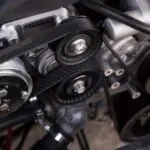Efficient and Eco-Friendly: Top Tips for Maintaining Your Hybrid Car

Hybrid cars are vehicles that combine the use of an internal combustion engine with an electric motor. This combination allows for improved fuel efficiency and reduced emissions compared to traditional gasoline-powered cars. The electric motor is powered by a battery pack that is charged through regenerative braking and the internal combustion engine. When the car is in motion, the electric motor assists the engine, reducing the workload and improving fuel economy.
One of the main benefits of owning a hybrid car is its fuel efficiency. Hybrid cars can achieve significantly higher miles per gallon (MPG) compared to conventional gasoline-powered cars. This means that hybrid car owners can save money on fuel costs in the long run. Additionally, hybrid cars produce fewer emissions, which is better for the environment.
Key Takeaways
- Hybrid cars are different from traditional cars because they use both an electric motor and a gasoline engine.
- Regular maintenance is crucial for keeping your hybrid car running efficiently and avoiding costly repairs.
- To prolong the life of your hybrid car’s battery, avoid extreme temperatures and use regenerative braking whenever possible.
- Proper tire maintenance can improve fuel efficiency and overall performance of your hybrid car.
- Regular fluid checks, including oil changes, are important for maintaining the health of your hybrid car’s engine and other systems.
Regular Maintenance: The Key to Keeping Your Hybrid Car Running Efficiently
Regular maintenance is crucial for keeping your hybrid car running efficiently. Just like any other vehicle, hybrid cars require routine maintenance to ensure optimal performance and longevity. This includes regular oil changes, tire rotations, brake inspections, and fluid checks.
Following the recommended maintenance schedule provided by the manufacturer is essential for keeping your hybrid car in top shape. This schedule typically includes specific intervals for oil changes, tire rotations, and other maintenance tasks. By following this schedule, you can catch any potential issues early on and prevent them from becoming major problems.
While some maintenance tasks can be done by the owner, such as checking tire pressure and fluid levels, it is recommended to have professional maintenance performed on your hybrid car. Hybrid cars have complex systems that require specialized knowledge and equipment for proper maintenance. Taking your car to a certified hybrid technician ensures that it receives the necessary care and attention it needs.
Battery Maintenance: Tips for Prolonging the Life of Your Hybrid Car’s Battery
The battery is one of the most critical components of a hybrid car. It powers the electric motor and stores energy generated through regenerative braking. To prolong the life of your hybrid car’s battery, it is essential to understand how it works and how to maintain it properly.
Hybrid car batteries are typically made of nickel-metal hydride (NiMH) or lithium-ion (Li-ion) cells. These batteries have a limited lifespan and will eventually need to be replaced. However, there are several steps you can take to maximize the battery’s life.
One of the signs of a failing hybrid car battery is a decrease in fuel efficiency. If you notice that your hybrid car is not achieving the same MPG as before, it may be a sign that the battery is deteriorating. Other signs include a decrease in power and difficulty starting the car.
To prolong the life of your hybrid car’s battery, it is important to avoid extreme temperatures. High temperatures can cause the battery to degrade faster, while extremely cold temperatures can reduce its efficiency. Additionally, avoid fully depleting the battery and try to keep it charged between 20% and 80% for optimal performance.
Tire Maintenance: Maximizing Fuel Efficiency and Performance
| Tire Maintenance Metrics | Description |
|---|---|
| Tire Pressure | The amount of air pressure in the tire affects fuel efficiency and performance. Proper tire pressure can improve fuel efficiency by up to 3%. |
| Tire Tread Depth | The depth of the tire tread affects traction and handling. Tires with low tread depth can increase stopping distance and reduce fuel efficiency. |
| Tire Rotation | Rotating tires regularly can help ensure even wear and extend the life of the tires. This can also improve fuel efficiency and performance. |
| Wheel Alignment | Proper wheel alignment can improve handling and reduce tire wear. Misaligned wheels can cause uneven wear and reduce fuel efficiency. |
| Tire Balancing | Unbalanced tires can cause vibration and uneven wear. Proper tire balancing can improve handling and extend the life of the tires. |
Proper tire maintenance is crucial for maximizing fuel efficiency and performance in any vehicle, including hybrid cars. Well-maintained tires can improve traction, handling, and overall safety on the road.
One of the most important aspects of tire maintenance is maintaining the correct tire pressure. Underinflated tires can increase rolling resistance, which reduces fuel efficiency. On the other hand, overinflated tires can lead to uneven wear and reduced traction. It is recommended to check your tire pressure regularly and inflate them to the manufacturer’s recommended PSI (pounds per square inch).
In addition to maintaining proper tire pressure, it is also important to rotate your tires regularly. This helps ensure even wear and extends their lifespan. The recommended interval for tire rotations varies depending on the vehicle and driving conditions, but a general guideline is every 5,000 to 7,000 miles.
To further maximize fuel efficiency and performance, consider investing in low rolling resistance tires. These tires are designed to reduce friction with the road, resulting in improved fuel economy. They are specifically engineered to minimize energy loss and provide a smoother ride.
Fluid Maintenance: The Importance of Regular Oil Changes and Other Fluid Checks
Regular oil changes are essential for maintaining the health and performance of any vehicle, including hybrid cars. Oil lubricates the engine’s moving parts, reduces friction, and helps dissipate heat. Over time, oil breaks down and becomes less effective, which can lead to engine damage if not replaced regularly.
The recommended interval for oil changes in hybrid cars varies depending on the make and model. It is important to follow the manufacturer’s guidelines for oil change intervals to ensure optimal engine performance. Additionally, hybrid cars may require a specific type of oil, so it is important to use the recommended oil viscosity and specification.
In addition to regular oil changes, it is also important to check and maintain other fluids in your hybrid car. This includes coolant, brake fluid, transmission fluid, and power steering fluid. These fluids play a crucial role in the proper functioning of various systems in your car and should be checked regularly.
The recommended maintenance schedule for fluid checks varies depending on the fluid and the vehicle. It is important to consult your owner’s manual or speak with a certified hybrid technician to determine the appropriate intervals for checking and replacing fluids.
Brakes and Suspension: Keeping Your Hybrid Car Safe and Running Smoothly

Proper maintenance of your hybrid car’s brakes and suspension is essential for both safety and performance. The brakes are responsible for slowing down or stopping your vehicle, while the suspension system ensures a smooth ride by absorbing bumps and vibrations.
Regular brake inspections are crucial for ensuring that your brakes are functioning properly. Signs of brake issues include squeaking or grinding noises, a soft or spongy brake pedal, and vibrations when braking. If you notice any of these signs, it is important to have your brakes inspected and repaired as soon as possible.
The suspension system should also be inspected regularly to ensure that it is in good working condition. Signs of suspension issues include a bumpy or uncomfortable ride, uneven tire wear, and excessive bouncing or swaying. If you notice any of these signs, it is important to have your suspension system inspected and repaired.
The recommended maintenance schedule for brakes and suspension varies depending on the vehicle and driving conditions. It is important to consult your owner’s manual or speak with a certified hybrid technician to determine the appropriate intervals for brake and suspension maintenance.
Eco-Friendly Driving Habits: How to Get the Most Out of Your Hybrid Car’s Fuel Economy
One of the main advantages of owning a hybrid car is its fuel economy. To maximize fuel efficiency and get the most out of your hybrid car, it is important to practice eco-friendly driving habits.
One of the most effective ways to improve fuel economy is to avoid aggressive driving. Rapid acceleration and hard braking can significantly reduce fuel efficiency. Instead, try to accelerate and decelerate smoothly and maintain a consistent speed whenever possible.
Another eco-friendly driving habit is to avoid idling for extended periods. If you anticipate being stopped for more than a minute, it is more fuel-efficient to turn off your engine and restart it when you are ready to move again. Additionally, using the air conditioning sparingly can help improve fuel economy.
Planning your trips efficiently can also help maximize fuel economy. Combining multiple errands into one trip and avoiding unnecessary detours can reduce mileage and save fuel. Additionally, using navigation systems or smartphone apps that provide real-time traffic information can help you avoid congested routes and save time and fuel.
Charging and Fueling: Best Practices for Hybrid Car Owners
Hybrid cars have both an electric motor and an internal combustion engine, which means they require both charging and fueling. Understanding the best practices for charging and fueling your hybrid car is essential for optimal performance and efficiency.
To charge a hybrid car, you will need access to a charging station or an electrical outlet. Most hybrid cars come with a charging cable that can be plugged into a standard household outlet. However, for faster charging, it is recommended to use a dedicated charging station. These stations provide higher voltage and can charge your hybrid car more quickly.
When fueling your hybrid car, it is important to use the recommended fuel type. Most hybrid cars are designed to run on regular unleaded gasoline, but some models may require premium gasoline. Consult your owner’s manual or speak with a certified hybrid technician to determine the appropriate fuel type for your specific vehicle.
It is also important to avoid overfilling the fuel tank. Overfilling can lead to fuel spillage and can damage the evaporative emissions control system. Additionally, try to avoid topping off the tank after the pump automatically shuts off. This can cause fuel to enter the evaporative emissions control system, leading to potential issues.
Winter Driving: Preparing Your Hybrid Car for Cold Weather Conditions
Winter driving can be challenging, especially for hybrid cars. Cold temperatures can affect the performance of the battery and reduce overall fuel efficiency. To prepare your hybrid car for winter conditions, there are several steps you can take.
One of the most important aspects of winter preparation is ensuring that your battery is in good condition. Cold temperatures can reduce the efficiency of the battery, so it is important to have it inspected before winter hits. Additionally, keeping your battery charged between 20% and 80% can help maintain its performance in cold weather.
Proper tire maintenance is also crucial for winter driving. Make sure your tires are properly inflated and have sufficient tread depth for optimal traction on snow and ice. Consider switching to winter tires if you live in an area with heavy snowfall or icy conditions.
To drive safely in winter conditions, it is important to adjust your driving habits accordingly. Reduce your speed, increase your following distance, and avoid sudden maneuvers. Additionally, make sure your windshield wipers are in good condition and use winter-grade windshield washer fluid to ensure clear visibility.
The recommended winter maintenance schedule for hybrid cars may include additional tasks such as checking the coolant concentration, inspecting the heater system, and testing the battery’s cold cranking amps. Consult your owner’s manual or speak with a certified hybrid technician to determine the appropriate winter maintenance tasks for your specific vehicle.
Hybrid Car Accessories: Upgrades and Add-Ons for Improved Performance and Efficiency
There are several accessories available for hybrid cars that can improve performance, efficiency, and overall driving experience. These accessories are designed specifically for hybrid cars and can enhance their capabilities.
One of the recommended accessories for hybrid cars is a battery charger or maintainer. This accessory allows you to charge your hybrid car’s battery when it is not in use, ensuring that it is always at optimal levels. This can help prolong the life of the battery and maintain its performance.
Another useful accessory for hybrid cars is a smartphone app or dashboard display that provides real-time information about fuel economy and energy usage. These apps can help you monitor your driving habits and make adjustments to maximize fuel efficiency.
Other accessories that can improve performance and efficiency include aerodynamic enhancements such as rear spoilers or underbody panels. These accessories reduce drag and improve airflow around the vehicle, resulting in improved fuel economy.
When choosing accessories for your hybrid car, it is important to consider their compatibility with your specific make and model. Consult your owner’s manual or speak with a certified hybrid technician to determine the best accessories for your hybrid car.
In conclusion, hybrid cars offer several advantages over traditional gasoline-powered cars, including improved fuel efficiency and reduced emissions. To keep your hybrid car running efficiently, regular maintenance is crucial. This includes following the recommended maintenance schedule, checking and maintaining fluids, and inspecting and maintaining the brakes and suspension. Additionally, practicing eco-friendly driving habits, charging and fueling correctly, preparing for winter conditions, and considering accessories can further enhance the performance and efficiency of your hybrid car. By taking these steps, you can enjoy the benefits of owning a hybrid car for years to come.
If you’re interested in hybrid car maintenance tips, you might also find this article on Workshop Manuals helpful. It provides a comprehensive workshop manual for Alpha Romeo, offering detailed instructions and guidance for maintaining and repairing your vehicle. Whether you’re dealing with issues like reverse not working in your Ford Transit Connect or facing overheating problems with your Ford Fiesta, this resource can be a valuable tool to keep your hybrid car running smoothly. Check out the Workshop Manuals for more information and expert advice.
FAQs
What is a hybrid car?
A hybrid car is a vehicle that combines a traditional gasoline engine with an electric motor and battery pack to improve fuel efficiency and reduce emissions.
What are some benefits of owning a hybrid car?
Hybrid cars offer several benefits, including improved fuel efficiency, reduced emissions, and potential cost savings on fuel and maintenance over time.
What are some common maintenance tasks for hybrid cars?
Common maintenance tasks for hybrid cars include regular oil changes, tire rotations, brake inspections, and battery checks.
Do hybrid cars require special maintenance compared to traditional gasoline cars?
Hybrid cars do require some special maintenance compared to traditional gasoline cars, such as regular battery checks and potential replacement of the hybrid battery pack over time.
Can I perform maintenance on my hybrid car myself?
Some basic maintenance tasks, such as checking tire pressure and changing air filters, can be performed by the owner. However, more complex tasks, such as battery replacement, should be performed by a trained professional.
How often should I have my hybrid car serviced?
The frequency of service for a hybrid car will depend on the make and model, as well as the driving conditions. It is recommended to follow the manufacturer’s recommended maintenance schedule.
Are there any special precautions I should take when working on a hybrid car?
Yes, there are some special precautions to take when working on a hybrid car, such as disabling the high-voltage system and wearing appropriate safety gear. It is recommended to have a trained professional perform any complex maintenance tasks.









